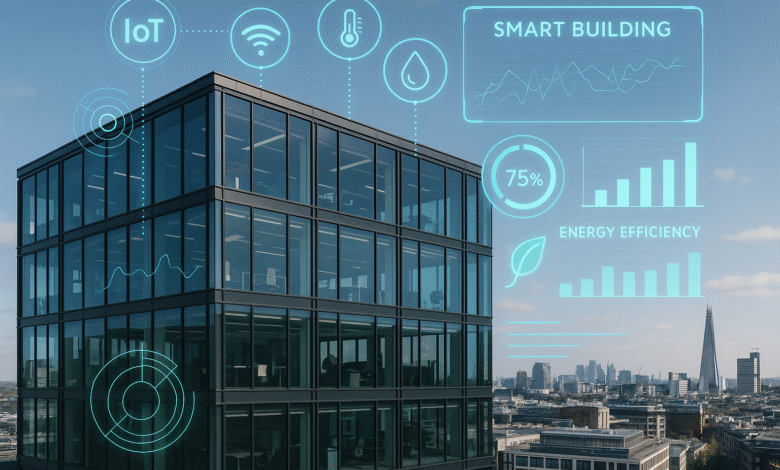
The commercial property landscape in the United Kingdom is undergoing a transformative shift, with smart building management systems emerging as a crucial catalyst for operational efficiency and cost reduction. As energy costs continue to soar and environmental regulations become increasingly stringent, UK commercial property owners are turning to intelligent building solutions to optimise their operations while maintaining competitive advantage.
Smart building management represents a paradigm shift from traditional facility management approaches, leveraging Internet of Things (IoT) technology to create interconnected, responsive environments that adapt to real-time conditions. This comprehensive approach to building automation encompasses everything from HVAC optimisation to predictive maintenance, delivering substantial cost savings while enhancing occupant comfort and productivity.
Understanding Smart Building Management Systems
Smart building management systems integrate various IoT devices, sensors, and automated controls to create a unified platform for monitoring and controlling building operations. These sophisticated systems collect vast amounts of data from multiple sources, including environmental sensors, occupancy detectors, energy meters, and security systems, processing this information to make intelligent decisions about building operations.
The core components of modern smart building management include centralised building management systems (BMS), wireless sensor networks, cloud-based analytics platforms, and mobile applications for remote monitoring and control. These elements work together to create a seamless ecosystem where building performance is continuously monitored, analysed, and optimised.
UK commercial properties implementing smart building management typically see immediate improvements in energy efficiency, with many organisations reporting energy consumption reductions of 20-30% within the first year of implementation. This dramatic improvement stems from the system’s ability to identify inefficiencies, automate routine operations, and provide detailed insights into building performance patterns.
The Role of IoT in Modern Building Operations
Internet of Things technology serves as the foundation for smart building management, enabling seamless communication between various building systems and components. IoT sensors deployed throughout commercial properties collect real-time data on temperature, humidity, air quality, lighting levels, occupancy patterns, and equipment performance.
This continuous data collection creates a comprehensive picture of building operations, allowing facility managers to identify trends, predict maintenance needs, and optimise resource allocation. IoT-enabled building automation systems can automatically adjust HVAC settings based on occupancy levels, dim lights in unoccupied areas, and alert maintenance teams to potential equipment failures before they occur.
The integration of IoT technology with smart building management systems also enables predictive analytics capabilities, where machine learning algorithms analyse historical data to forecast future maintenance requirements and optimise building performance. This proactive approach to facility management significantly reduces unexpected downtime and extends equipment lifespan.
Energy Efficiency and Cost Reduction Strategies
Energy consumption represents one of the largest operational expenses for UK commercial properties, making energy efficiency a primary focus for smart building management implementation. Intelligent building systems achieve significant cost savings through various automated strategies designed to minimise energy waste while maintaining optimal comfort levels.
Automated lighting controls utilise occupancy sensors and daylight harvesting technology to ensure lights are only activated when needed and dimmed appropriately based on natural light availability. This approach can reduce lighting energy consumption by up to 60% in typical commercial buildings, resulting in substantial cost savings over time.
Smart HVAC management systems continuously monitor indoor air quality, temperature, and humidity levels, automatically adjusting heating, cooling, and ventilation systems to maintain optimal conditions with minimal energy consumption. These systems can also implement demand-based ventilation strategies, reducing energy usage during periods of low occupancy.
Building envelope optimisation through smart windows and automated shading systems helps regulate internal temperatures naturally, reducing the burden on mechanical heating and cooling systems. This integrated approach to energy management creates a synergistic effect where multiple systems work together to achieve maximum efficiency.
Also Read: Best Smart Home IoT Devices Available in the UK
Predictive Maintenance and Equipment Optimisation
Traditional reactive maintenance approaches often result in costly emergency repairs and extended downtime that disrupts business operations. Smart building management systems revolutionise maintenance strategies by implementing predictive maintenance protocols that identify potential equipment failures before they occur.
IoT sensors continuously monitor equipment performance parameters such as vibration levels, temperature variations, energy consumption patterns, and operational cycles. Machine learning algorithms analyse this data to identify anomalies that indicate potential equipment failures, allowing maintenance teams to schedule repairs during convenient times rather than responding to emergency situations.
This predictive approach to maintenance typically reduces maintenance costs by 25-30% while extending equipment lifespan and improving overall building reliability. The system can also optimise maintenance schedules based on actual equipment usage patterns rather than arbitrary time intervals, ensuring resources are allocated efficiently.
Equipment performance optimisation extends beyond maintenance to include operational efficiency improvements. Smart building management systems can automatically adjust equipment settings based on real-time conditions, ensuring optimal performance while minimising energy consumption and wear on mechanical components.
Occupant Comfort and Space Utilisation
Modern commercial properties must balance cost reduction with occupant satisfaction, as comfortable, productive environments are essential for business success. Smart building management systems excel at maintaining optimal indoor conditions while minimising energy consumption through intelligent space utilisation and environmental control strategies.
Occupancy analytics utilise various sensors to monitor space utilisation patterns, identifying underutilised areas and optimising resource allocation accordingly. This data-driven approach to space management enables property managers to make informed decisions about space allocation, potentially reducing overall space requirements and associated costs.
Indoor air quality monitoring ensures healthy environments by continuously tracking pollutant levels, humidity, and ventilation rates. Smart systems can automatically adjust ventilation rates based on occupancy levels and air quality measurements, maintaining healthy conditions while avoiding energy waste from over-ventilation.
Personalised comfort controls through mobile applications allow occupants to adjust environmental settings within their immediate workspace, improving satisfaction while enabling the building management system to optimise overall energy consumption across the property.
Technology Integration and Scalability
Successful smart building management implementation requires careful consideration of technology integration and scalability requirements. Modern systems must accommodate various communication protocols, legacy equipment, and future expansion needs while maintaining reliable performance and security.
Cloud-based platforms provide the computational power and storage capacity necessary for processing vast amounts of sensor data and implementing complex analytics algorithms. These platforms also enable remote monitoring and control capabilities, allowing facility managers to oversee multiple properties from centralised locations.
Interoperability standards ensure that various building systems can communicate effectively, preventing technology silos that limit system effectiveness. Open protocols and standardised interfaces enable seamless integration between different manufacturers’ equipment and systems.
Scalability considerations include the ability to add new sensors, expand system capabilities, and integrate emerging technologies as they become available. Modular system architectures allow for gradual implementation and expansion, reducing initial investment requirements while providing flexibility for future growth.
Implementation Challenges and Solutions
While smart building management offers significant benefits, successful implementation requires careful planning and execution to overcome common challenges. Understanding these obstacles and their solutions is crucial for achieving successful project outcomes.
Initial investment costs represent a significant barrier for many commercial property owners, particularly when considering comprehensive system upgrades. However, financing options such as energy service company (ESCO) agreements and government incentives can help offset these costs while providing immediate access to smart building technologies.
Integration complexity arises when connecting new smart systems with existing building infrastructure and legacy equipment. Professional system integrators with extensive experience in building automation can navigate these challenges, ensuring seamless integration while minimising disruption to ongoing operations.
Cybersecurity concerns are paramount when implementing IoT-based building management systems, as these networks create potential entry points for malicious actors. Robust security protocols, regular system updates, and comprehensive monitoring systems are essential for protecting building operations and sensitive data.
Staff training requirements ensure that facility management teams can effectively operate and maintain smart building systems. Comprehensive training programs and ongoing support services help maximise system effectiveness while building internal capability for system management.
Return on Investment and Financial Benefits
The financial benefits of smart building management extend far beyond simple energy cost savings, encompassing various operational improvements that contribute to overall property value and profitability. Understanding these diverse benefits is crucial for evaluating the true return on investment for smart building technologies.
Energy cost reductions typically provide the most immediate and measurable financial benefits, with many UK commercial properties achieving 20-40% reductions in energy consumption within the first year of implementation. These savings compound over time, often resulting in payback periods of 3-5 years for comprehensive smart building management systems.
Maintenance cost reductions through predictive maintenance strategies can save 25-30% compared to traditional reactive maintenance approaches. These savings result from reduced emergency repair costs, extended equipment lifespan, and improved maintenance scheduling efficiency.
Productivity improvements from enhanced occupant comfort and optimised environmental conditions can significantly impact tenant satisfaction and retention rates. Studies indicate that improved indoor environmental quality can increase productivity by 6-9%, translating to substantial value for commercial property owners.
Property value enhancement occurs as smart building technologies become increasingly important for attracting quality tenants and achieving premium rental rates. Properties with advanced building management systems often command higher rental rates and experience lower vacancy rates compared to conventional buildings.
Future Trends and Emerging Technologies
The future of smart building management continues to evolve rapidly, with emerging technologies promising even greater efficiency gains and cost reduction opportunities. Staying informed about these developments is essential for commercial property owners seeking to maintain competitive advantage.
Artificial intelligence and machine learning capabilities are becoming increasingly sophisticated, enabling more accurate predictive analytics and automated decision-making processes. These technologies will further enhance system performance while reducing the need for manual intervention in building operations.
Edge computing technologies are bringing processing power closer to IoT sensors, reducing latency and improving system responsiveness while minimising bandwidth requirements. This approach enables more sophisticated real-time analytics and faster response times for critical building systems.
Integration with renewable energy systems and energy storage technologies is becoming increasingly important as the UK moves toward net-zero emissions targets. Smart building management systems will play a crucial role in optimising the use of renewable energy sources and managing energy storage systems.
Digital twin technology creates virtual replicas of physical buildings, enabling advanced simulation and optimisation capabilities. These digital models allow facility managers to test various scenarios and optimise building performance before implementing changes in the physical environment.
Conclusion
Smart building management represents a transformative opportunity for UK commercial property owners to achieve significant cost savings while enhancing operational efficiency and occupant satisfaction. Through the strategic implementation of IoT technology and intelligent building automation systems, properties can reduce energy consumption, optimise maintenance operations, and improve overall building performance.
The financial benefits of smart building management extend far beyond simple cost reductions, encompassing productivity improvements, property value enhancement, and competitive advantage in an increasingly technology-driven marketplace. As energy costs continue to rise and environmental regulations become more stringent, smart building management systems will become increasingly essential for commercial property success.
Successful implementation requires careful planning, appropriate technology selection, and comprehensive training for facility management teams. However, the long-term benefits of smart building management far outweigh the initial investment requirements, providing sustainable cost savings and operational improvements that continue to deliver value over time.
Commercial property owners who embrace smart building management today will be well-positioned to meet future challenges while maintaining competitive advantage in an evolving marketplace. The integration of IoT technology with intelligent building systems represents not just a technological upgrade, but a fundamental shift toward more efficient, sustainable, and profitable commercial property operations.







